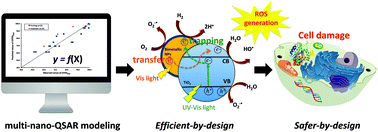A chemoinformatics approach for the characterization of hybrid nanomaterials: safer and efficient design perspective†
Abstract
In this study, photocatalytic properties and in vitro cytotoxicity of 29 TiO2-based multi-component nanomaterials (i.e., hybrids of more than two composition types of nanoparticles) were evaluated using a combination of the experimental testing and supervised machine learning modeling. TiO2-based multi-component nanomaterials with metal clusters of silver, and their mixtures with gold, palladium, and platinum were successfully synthesized. Two activities, photocatalytic activity and cytotoxicity, were studied. A novel cheminformatic approach was developed and applied for the computational representation of the photocatalytic activity and cytotoxicity effect. In this approach, features of investigated TiO2-based hybrid nanomaterials were reflected by a series of novel additive descriptors for hybrid and hybrid nanostructures (denoted as “hybrid nanosctructure descriptors”). These descriptors are based on quantum chemical calculations and the Smoluchowski equation. The obtained experimental data and calculated hybrid-nanostructure descriptors were used to develop novel predictive Quantitative Structure–Activity Relationship computational models (called “nano-QSARmix”). The proposed modeling approach is an initial step in the understanding of the relationships between physicochemical properties of hybrid nanoparticles, their toxicity, and photochemical activity under UV-vis irradiation. Acquired knowledge supports the safe-by-design approaches relevant to the development of efficient hybrid nanomaterials with reduced hazardous effects.



 Please wait while we load your content...
Please wait while we load your content...
